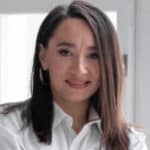It’s no secret that most businesses hate dealing with returns. Whether it’s because of the hassle of dealing with customer service or because you simply don’t have the time, returns can be a real pain.
But what if there was a way to avoid them altogether? Perhaps with a no returns policy?
While it may sound counterintuitive, having a no returns policy can actually be beneficial for both your business and consumers. For a business owner like yourself, it can save on costs associated with processing returns.
For your customers, it eliminates the hassle of having to keep track of return paperwork and ensures that they only receive products that they are happy with. None of those buy now think later scenarios.
And did you know that shoppers who are faced with a no returns policy are more likely to make a purchase than those who are not? The reasoning behind this is that shoppers feel more confident in their purchase when they know they can’t return it. More sales for you possibly?
Though there are benefits to having a no returns policy, if you’re thinking of implementing it, there are a couple of things you need to know to stay compliant with the legal side of things.
In this article, we’ll go over what you need to know when drafting your own no returns policy. Plus, we’ll look at the legalities as well as how they could affect your business if you get it wrong.
- Implementing a no returns policy can save you costs associated with processing returns and can increase customer purchase confidence.
- You must ensure their no returns policy is clearly displayed and compliant with local laws to avoid legal issues.
- While a no returns policy may deter returns, it can also hurt sales and damage your reputation if not managed properly.
Table of Contents
PRO TIP: Take the hassle of writing your own return policy away with our return and refund policy generator trusted by over 200,000 businesses. It’ll save you hours of work and help increase sales in minutes.
What is a No Returns Policy?
A no returns policy is exactly what it sounds like – it prohibits customers from returning items they’ve purchased. This type of policy is rather common and is usually used in situations where returns are either not possible due to the nature of the product or too costly for the retailer.
There are a few different types of no returns policies, including:
No Refunds
This policy means that customers can’t receive a refund. Sometimes there may be exceptions though, for example, if the product is defective.
No Exchanges
As the name suggests, this policy doesn’t allow customers to exchange an item. Again, there may be exceptions present if needed.
No Cancellations
Under this policy, customers can’t cancel an order after it’s been placed. This is common for made-to-order or customized items.
While no returns policies are becoming more common, they’re not right for every business. Many customers expect to be able to return items they’re unsatisfied with, and a no returns policy could hurt your sales. So keep this in mind before you decide to put it into action.
Before implementing a no returns policy, it’s important to understand the legality of having one. If you get it wrong, you might be breaking the law without even knowing it.
Is a No Returns Policy Legal?
This depends greatly on your country or state’s laws. Let’s take a look at a few examples:
USA
The Federal Trade Commission (FTC) requires that all businesses have a refund and return policy that’s “clearly and conspicuously” displayed. This means that customers must be able to easily find and understand your policy before making a purchase.
While the FTC doesn’t explicitly prohibit no returns policies, they require businesses to refund customers if an item is defective, damaged in transit, or not as described.
Canada
In Canada, the Competition Bureau requires that businesses have a refund and return policy that’s “prominently and reasonably conspicuously” displayed. The Canadian Consumer Protection Act also gives customers the right to cancel an order within seven days, regardless of the reason.
While businesses are not required to offer refunds, exchanges, or cancellations, they must clearly state their policy in a way that’s easy for customers to understand.
UK
The Consumer Contracts Regulations give customers the right to cancel an order within 14 days, regardless of the reason.
Europe
The old continent takes a similar approach as the USA, in that businesses must have a refund and return policy that’s “clearly and conspicuously” displayed. The Directive on Consumer Rights also gives customers the right to cancel an order within 14 days, regardless of the reason.
Australia
The Australian Consumer Law is similar to the USA and Europe and requires businesses to display their refund and return policy, and customers have the right to cancel an order within 14 days.
There are some instances where a no returns policy makes sense for a business. For example, if you sell food or perishable items, you obviously can’t take back something that’s been opened and used. The same goes for customized or made-to-order items – once they’ve been created, they can’t be resold.
Now that we’ve covered the legalities of no returns policies, let’s look at how a no returns policy could impact your business.
Why a No Returns Policy Can Be Bad for Your Business?
There are a few reasons why a no returns policy could hurt your business, including:
It Could Hurt Your Sales
A study by UPS found that 68% of shoppers check a store’s return policy before making a purchase, and 60% said they’re more likely to shop with a retailer that offers free returns.
It Could Damage Your Reputation
Customers expect to be able to return items they’re unsatisfied with, and a no returns policy could damage your reputation. In fact, 94% of shoppers say they’re less likely to shop with a store again after a bad return experience.
It Could Increase Your Costs
While a no returns policy might save you money in the short term by preventing customers from returning items, it could also increase your costs in the long run. This is because customers with a bad experience with your return policy are likely to tell their friends and family about it, which could hurt your sales.
It Could Lead to Legal Issues
As we saw above, many countries legally require businesses to refund customers if an item is defective, damaged in transit, or not as described. You could be violating the law if you have a no returns policy.
In some instances, no returns policies may not make sense. This includes if you sell:
- Food or perishable items
- Customized or made-to-order items
- Digital products
Before you sit down and write a no returns policy for your own store, ensure you understand the law and how it applies to your business. It would be best to consider how a no returns policy could impact your sales, reputation, and costs.
Examples of No Returns Policies You Can Learn From
Standard Pennant
In Standard Pennant’s return policy, they lay out that all returns must be completed within 15 days. Any items outside of the 15-day window are now nonreturnable and would not be eligible for an exchange or refund of any kind.
Return windows are a great way for businesses to limit return fraud and prevent consumers from buying, using, and returning items to get a free purchase.
Additionally, the store states that all items have to have prior approval if customers want to make a return. The prior approval adds an extra check to ensure that returns are fair before even initiating the process.
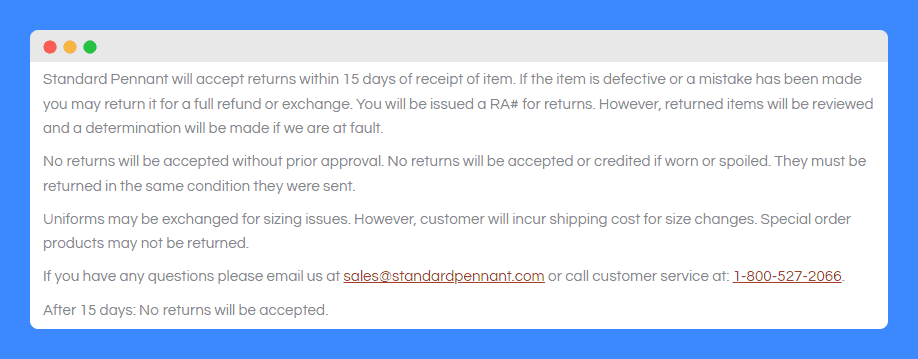
Family Dollar
Family Dollar is a physical and eCommerce store that’s known for providing low-cost items to families and individuals.
in their refund policy, Family Dollar states that all returns must be presented with the original receipt. On top of that, certain items are considered final sales and aren’t returnable.
The store’s policy of requiring a receipt for the return helps prevent return fraud and ensures that customers are returning items that the store can re-sell later. That, in turn, helps prevent losses.

Puppy Culture
Puppy Culture is an eCommerce store that specializes in puppy care e-courses and videos. This company has a special clause in its return policy that states which items are non-returnable.
For the most part, this company outlines that all digital products are non-returnable. As a result, customers can only get a refund or exchange for physical items purchased from the store.
On top of that, the store reserves the right to change its policy at any time. This means that customers have to be vigilant about the current policy to make sure their product is still eligible for returns.
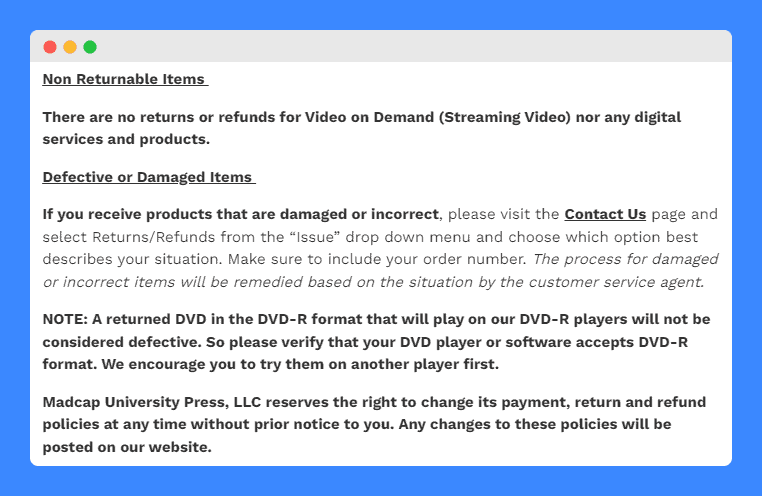
Atkins Farms
Atkins Farms is a grocery store chain with a return policy stating that some returns may only be valid with manager approval.
Additionally, this policy states that some items aren’t eligible for returns at all. These include reduced and clearance items, holiday items, and gift basket items.
This is a great example of how you can limit return policies without negating them altogether.
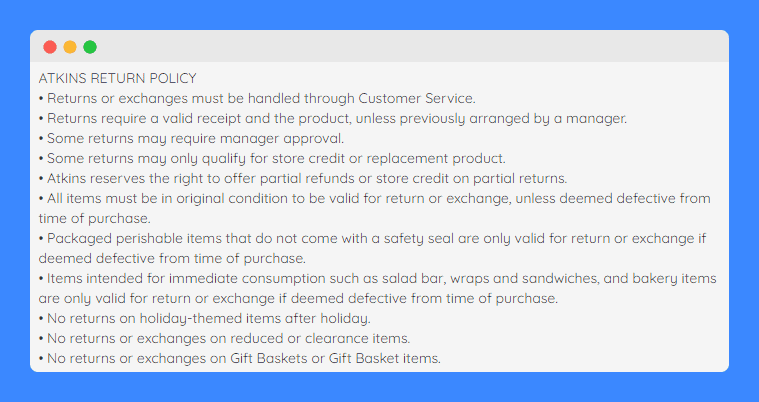
Sample No Returns Policy Template
Creating a straightforward no returns policy is important to set clear expectations for your customers. While there are common elements typically found in such policies, it’s essential to adapt them to fit your business’s specific needs.
To assist you, we’ve prepared this sample no returns policy template. Keep in mind that this is a starting point, and you should customize it to reflect the unique products or services you offer, as well as any particular conditions and potential liabilities.
Download this template in your preferred format and modify it as necessary to ensure it aligns perfectly with your business requirements.
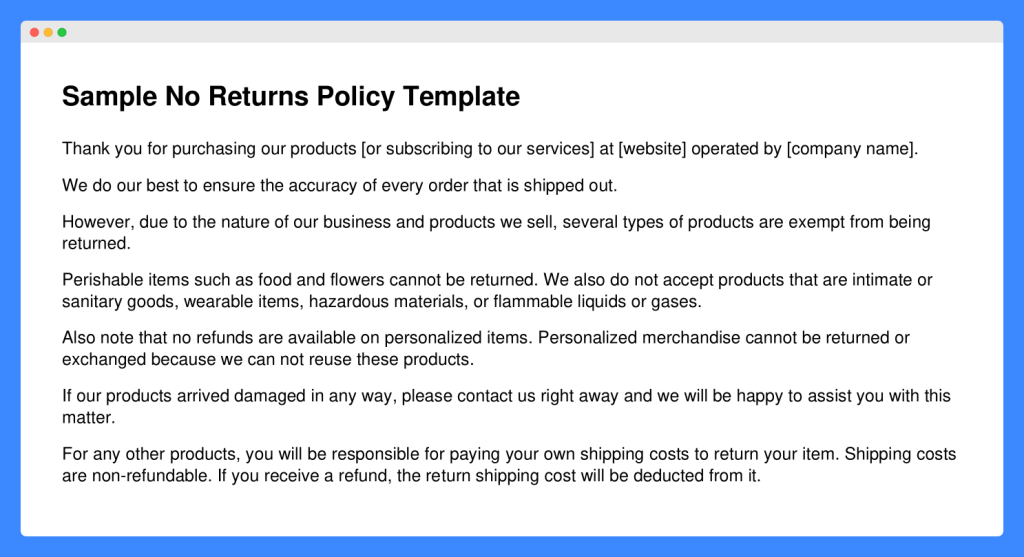
How to Write Your Own No Returns Policy?
Creating a no returns or all-sales final policy can be tricky. That’s because you want to make sure that you’re preventing possible business losses without hurting customer experience.
Let’s take a look at how you can write one policy without upsetting or losing customers.
Be Clear
When writing a no returns policy for your business, you need to make sure that you’re very straightforward. Make sure that it’s immediately clear to customers that they’re not entitled to a refund or return after they make a purchase.
Also, make it clear about what special situations customers might be able to return the product. This usually relates to defective items or items that had quality issues. They may also state that returns are acceptable within a reasonable time period, such as within 30 days of purchase.
Consider Alternatives to Refunds
Just because you don’t want to allow refunds, you can still offer alternatives for customer returns. A few examples include:
- Offering exchanges.
- Issuing store credit.
- Allowing customers to reschedule for service-based purchases.
Pay Attention to the Law
Remember that some countries and states may require you to have a refund policy in place for certain situations. This could mean offering customers a product warranty or accepting products in the event that something is defective.
Before finalizing a return or refund policy for your business, make sure to look at what’s allowed and what’s not in your area. That way, you don’t get yourself into hot water later down the line.
Make it Easy to Find
In general, you’ll want to display your policy somewhere that’s easy to see.
For many eCommerce businesses, this means including it at checkout or displaying it in the navigation menu. That way, your customers know when they’re eligible for a refund or exchange and when they’re not.
Frequently Asked Questions
Why do businesses have no returns policies?
Some businesses sell products that are perishable or personalized thus making them difficult to resell again. Others want to protect themselves from customers abusing return policies.
What are the benefits of having a no returns policy
It protects your business from dealing with returns, exchanges, refunds, and the potential abuse of these policies by customers.
What are the cons of having a no returns policy?
It could deter your potential customers from shopping with you, as they know they can’t return items if they’re not happy with them.
Are there options besides cash refunds?
Yes! You can offer store credit, partial credit, coupons, and exchanges, to name a few. Any of these can be ways for your online business to save on cash losses.
Is a return the same as a refund?
A return is not the same as a refund. A return means that you are returning an item but not necessarily receiving the cash value of the item back, while a refund implies receiving cash for the value of the item upon return.
Create a Return Policy using WebsitePolicies
Take the guesswork out of the legal jargon with our smart generators & create a return policy personalized to your needs in minutes. Here’s how:
Step 1: Navigate to the return and refund policy generator.
Step 2: Answer some questions about your business and how you operate.
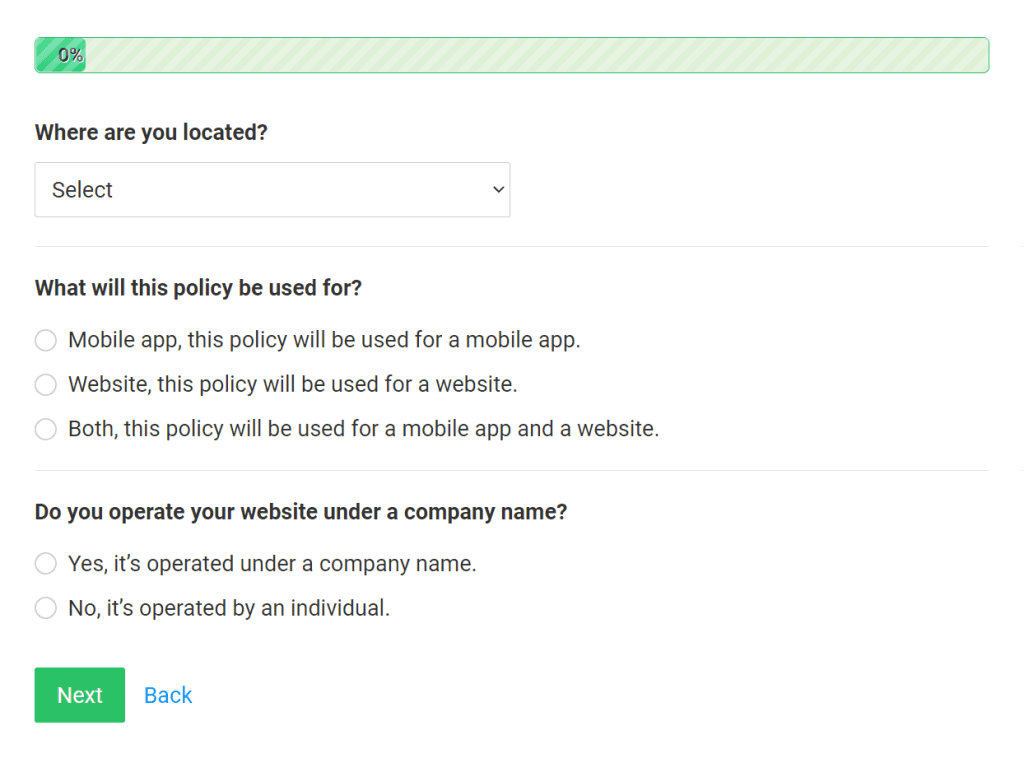
Step 3: Create an account and publish or copy your personalized return policy.
Create Your Return Policy